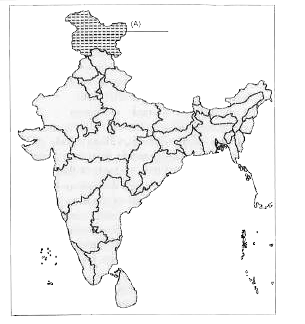a) Name the tropical sugar cane variety grown in South India. How has it helped in improving the sugar cane qality grown in North India?
b) Identify 'a', 'b' and 'c' in the following table:

(a) Saccharum officinarum, crossed with north Indian variety S, barberi to increase quality.
(b) Aphids (b) Jassids/aphids/fruit borer( c) Okra (Bhindi).
Topper's Solved these Questions
- BOOK - PRADEEPCHAPTER - STRATEGIES FOR ENHANCEMENT IN FOOD PRODUCTIONEXERCISE - SHORT ANSWER QUESTION FILL IN THE BLANKS10videos
STRATEGIES FOR ENHANCEMENT IN FOOD PRODUCTION
- BOOK - PRADEEPCHAPTER - STRATEGIES FOR ENHANCEMENT IN FOOD PRODUCTIONEXERCISE - LONG ANSWER QUESTIONS14videos
STRATEGIES FOR ENHANCEMENT IN FOOD PRODUCTION
- BOOK - PRADEEPCHAPTER - STRATEGIES FOR ENHANCEMENT IN FOOD PRODUCTIONEXERCISE - Additional Questions (SHORT ANSWER TYPE QUESTION) Fill in the blanks :5videos
STRATEGIES FOR ENHANCEMENT IN FOOD PRODUCTION
- BOOK - PRADEEPCHAPTER - SEXUAL REPRODUCTION IN FLOWERING PLANTSEXERCISE - Competition FOCUS NEET/AIIMS special (PRACTICE QUESTIONS (II. Assertion-Reason Type Questions ))19videos
SEXUAL REPRODUCTION IN FLOWERING PLANTS
Similar Questions
Knowledge Check
- Question 1 - Select One
Which tropical canes grown in south india had thicker stems and high sugar content but did not grow well in north India.
ASaccharum barberiBSaccharum spontaneumCSaccharum robustumDSaccharum officinarum - Question 2 - Select One
Which tropical canes grown in south india had thicker stems and high sugar content but did not grow well in north India.
ASaccharum barberiBSaccharum spontaneumCSaccharum robustumDSacchrum officinarum - Question 3 - Select One
Fill up the blanks -
Sacchamm barberi was originally grown in north India, but had (A) sugar content and yield. Tropical canes grown in south India Sacchamm officinamm had (B) stems and (C) sugar content but did not grow well in north India. These two species were successfully crossed to get sugar cane varieties combining the desirable qualities of high yield, (D) stems, (E) sugar and ability to grow in the sugar cane areas of (F) IndiaAA - poor, B - thick, C - high, D - thicker, E - higher, F - northBA- poor, B - thicker, C - higher, D - thick, E - high, F - northCA- poor, B - thinner, C - higher, D - thin, E - high, F - northDA - poor, B - thicker, C - higher, D - thick, E - high, F - south
Plant breeding technique has helped sugar industry in North india Explain how.
View SolutionIn this question below is given a statement followed by two assumptions numbered I and II.Consider the statement and decide which of the given assumption in implicit.
Give answer (a) if only assumption I is implicit : (b) if only assumption II is implicit: (c) If either I or II is implicit: (d) If neither I nor II is implicit and (e) If both I and II are implicit.
Statement : Even with the increase in the number of sugar factories in india. we still continue to import sugar .
Assumption: I. The consumption of sugar per capita has increased in India.
II. Many of the factories are not in a position to produce sugar to their fullest capacity.View Solution(a) One feature A is shown in the given political outline map of India. Identify this feature with the help of the following information and write its correct name on the line marked on the map: (A) A soil type
(b) On the same political outline map of India, locate and label the following features with appropriate symbols: (B) Bhakra Nangal Dam (C) A State which is the major producer of CottonView Solution(a) One item A is shown in the given political outline map of India. Identify this item with the help of following information and write its correct name on the line marked on the map.
(A) A Type of Soil
(ii) On the same political outline map of India, locate and label the following items with appropriate symbols.
(B) Sariska Wildlife Sanctuary
(C) Salal Dam
(30.3) In which State is Salal dam located?
 View Solution
View SolutionName the (a) Fruit sugar (b) Blood sugar (c) Milk Sugar (d) Cane sugar
View Solution

